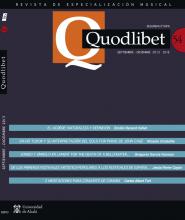|
New CD This CD features three large works for ensemble and electronics composed by Cristóbal Hallfter in the 1960 and 70s. "Planto por las víctimas de la violencia" (1970/71), for chamber ensemble (3 fl, 3 ob, 3 kl, 4 perc., pno, string quartet) and live-electronics, is the foundational piece of the Experimentalstudio of the Heinrich-Strobel-Stiftung. "Planto" is also the first composition to use the HA-LA-PHON, a pioneering spatialisation device that—together with a series of further analogue sound transformation prototypes—was purposely developed by Hans Peter Haller and Peter Lawo for this piece. Details |
|
Journal article Lament for the Death of a Bullfighter (1959) is a composition for voice and magnetic tape based on Federico García Lorca’s famous elegy Llanto por Ignacio Sánchez Mejías (1934). This article starts from the relationship between Gerhard and Lorca, and the composer’s views on the marriage between music and poetry. Seeking to understand the poietic space that oriented Gerhard’s decisions the author investigates the principles that govern the composition and its underlying musical thought. Through the use of selected musical examples the analysis gradually unveils how sonorous structure and poetic operations, sound composition and speech, emancipated music and emotional narrative, are skilfully interlaced in a dialectical relationship. Details |
|
Book chapter "Roberto Gerhard's BBC Sound Compositions" is the title of my contribution to The Roberto Gerhard Companion (Ashgate, 2013). This chapter examines the relationship between the British electroacoustic music pioneer Roberto Gerhard and the BBC. It is a primer on Gerhard's evolution as a composer of electroacoustic music based on an exhaustive survey of primary sources including the BBC's internal documentation, as well as the composer's private correspondence and magnetic tape collection. Sound compositions such as A Leak in the Universe (1955), Asylum Diary (1958), Lament for the Death of a Bullfighter (1959), and Symphony No. 3 "Collages" (1960) are examined. Details |
|
Essay "Closing the Gap between Sound and Score in the Performance of Electroacoustic Music" has recently been published in a collective book entitled "Sound and Score. Essays on Sound, Score and Notation" (Leuven University Press, 2013) generously coordinated by the Orpheus Instituut and Paulo de Assis, Cathleen Coessens and William Brooks (eds.). This chapter stands up for the often overlooked performative dimension of electroacoustic music. It revolves around the subjects of score and notation and touches upon a number of "classical problems" of electroacoustic music. On the basis of practical examples different modes of interaction between the score and the performer are investigated. The contexts examined include: Details |
|
Film This short film gives a front-row seat to the premiere of Roberto Gerhard's musical "divertimento" Claustrophilia (1966), for eight harps, four wireless receivers and two monitors. Claustrophilia was purposely conceived by Gerhard in response to John Cage's request for a manuscript page for his famous catalogue "Notations". Accompanying this page—sent to Cage as a "Christmas postcard" in December 1966—, Gerhard expressed his wish for John Cage and David Tudor to conduct its performance. This film picks up for the first time Gerhard's challenge in the year of John Cage's 100 anniversary. Details |




